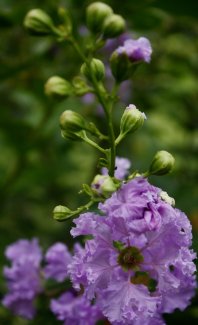China, Taiwan, Cambodia, Laos, Thailand, Vietnam
Shrubs or small trees, to 7 m tall. Branchlets slender, 4-angled or subalate, puberulous, glabrescent. Leaves sessile or with petiole to ca. 2 mm; leaf blade elliptic, oblong, obovate, or suborbicular, typically at least some suborbicular to obovate and mucronate, 2.5-7[-10] × 1.5-4 cm, papery to slightly leathery, glabrous or with slight indumentum on veins abaxially, lateral veins 3-7 pairs, base broadly cuneate to rounded, apex acute, obtuse with small mucro, or retuse. Panicles subpyramidal, 7-20 cm, puberulous, densely flowered. Floral tube 6-merous, 7-11 mm, smooth walled or obscurely to decidedly 6-ribbed, glabrous; sepals 3.5-5.5 mm, adaxially glabrous; annulus present; epicalyx absent. Petals purple, fuchsia, pink, or white, orbicular, 1.2-2 cm including claw 6-9 mm. Stamens 36-42, dimorphic. Ovary glabrous. Capsules ellipsoidal, 1-1.3 × 0.7-1.2 cm, 4-6-valved. Seeds including wing ca. 8 mm. Fl. Jun-Sep, fr. Sep-Nov. 2n = 48, 50.
L. indica started to be used in landscaping and gardening in Europe and America in 1759 (Sanchez, 2003). In the USA, the National Arboretum in Washington D.C. began a breeding project with L. indica in 1962. Major advances occurred when L. subcostata and L. fauriei were introduced into the breeding program in 1966. The resulting hybrids were highly ornamental and resistant to powdery mildew. At the present, the U.S. National Arboretum has released over 24 cultivars selected for cold hardiness, for resistance to powdery mildew, and for varying heights, habits, flower colours, autumn foliage colours, and bark characteristics (Moore and Walker, 2014). Straight species plants are not sold in commerce. A multitude of named cultivars from dwarf to tree size have been introduced over the years, many of which are hybrids between L. indica and L. faueri.
